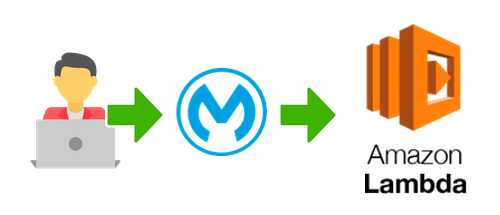Could AWS Lambda be used in place of MuleSoft?

The answer is “No”. Mulesoft would not entirely replace Amazon Web Services Lambda. Mulesoft is a commonly used Integrated Platform in the Cloud that integrates SaaS and Enterprise applications. In this blog, we will see the general comparisons among AWS Lambda and Mulesoft Anypoint Platform based on preference data from user reviews. With 589 votes, AWS Lambda receives a 4.5/5 rating. MuleSoft Anypoint Platform, on the other hand, has 488 ratings and a rating of 4.5/5. The score for a product is measured using real-time data from checked customer ratings to help you choose between these two choices and determine which is better for your company’s needs.
Platform Comparison of AWS Lambda and MuleSoft Anypoint
Reviewers considered the MuleSoft Anypoint Platform to be easier to use, set up, and manage while comparing the two solutions. Reviewers, on the other hand, agreed that both vendors made doing business convenient in general.
- AWS Lambda, rather than MuleSoft Anypoint Platform, seems to suit the needs of reviewers’ businesses better.
- Reviewers found that AWS Lambda was the better choice when it came to ongoing product support.
- The reviewers preferred AWS Lambda over MuleSoft Anypoint Platform for feature changes and roadmaps.
Comparative Analysis of Categories
There are no shared categories between AWS Lambda and MuleSoft Anypoint Platform. MuleSoft Anypoint Platform is classified as API Design, Message Queue (MQ), Electronic Data Interchange (EDI), API Marketplace, API Management, and iPaaS, while AWS Lambda is categorized as Cloud Platform as a Service (PaaS).
Comparative Analysis of Reviews
AWS Lambda and MuleSoft Anypoint Platform reviewers were also from Enterprise firms.
- The Small-Business has the range of 50 or fewer employees. The small business which is using AWS Lambda is 14.6%, and that of Mulesoft Anypoint Platform is 9.9%.
- The Mid-Market has a range of 51-1000 employees. The small business which is using AWS Lambda is 33.7%, and that of Mulesoft Anypoint Platform is 28.3%.
- The Enterprise organizations have more than 1000 employees working. The small business which is using AWS Lambda is 51.8% and that of Mulesoft Anypoint Platform is 61.8%.
Comparison of the Industries of the Reviewers
- The Computer Software industries which use AWS Lambda is 21.0% and that of Mulesoft Anypoint Platform is 10.7%.
- The Information Technology and Services industries that use AWS Lambda is 12.7% and that of Mulesoft Anypoint Platform is 42.9%.
- The Financial Services industries that use AWS Lambda is 11.0% and that of Mulesoft Anypoint Platform is 4.3%.
- Internet industries that use AWS Lambda are 4.0%.
- Telecommunications industries that use Mulesoft Anypoint Platform are 4.3%.
- The Retail industries which use AWS Lambda are 3.5% and that of Insurance is 2.7%.
- Other industries which use AWS Lambda are 47.8% and that of Mulesoft Anypoint Platform is 35.2%.
Overall Review Comparisons
- The Ease of Use is rated as 3.7/5 for AWS Lambda and that of Mulesoft Anypoint Platform is 4.4/5.
- The Customer Service is rated as 4.0/5 for AWS Lambda and that of Mulesoft Anypoint Platform is 4.2/5.
- The Features is rated as 4.3/5 for AWS Lambda and that of Mulesoft Anypoint Platform is 4.5/5.
- The Value for Money is rated as 3.0/5 for AWS Lambda and that of Mulesoft Anypoint Platform is 4.4/5.
Benefits and Disadvantages of AWS Lambda
The AWS Lambda service is an excellent example of serverless architecture – Providers handle the infrastructure at the processing execution layer in the cloud. It uses the cloud computing paradigm of Function as a Service (FaaS). This enables you to create and manage software and utilities without having to worry about managing infrastructure. Serverless platforms include Iron.io, Google Cloud Functions, IBM’s OpenWhisk project, Serverless, and Azure Functions. Let’s take a look at the advantages and disadvantages of serverless architecture, especially AWS Lambda.
Benefits of AWS Lambda:
1) Quicker Development
Serverless architecture has solved the challenges of system engineering, allowing product developers to innovate quickly. As a result, you spend less time dealing with operational issues, making DevOps jobs simpler.
2) Operational Management made easier
FaaS’s automatic scaling feature eliminates not only computing costs but also operating control overheads. The serverless architecture distinguishes between infrastructure resources and programs that run on top of it. System engineers should concentrate on the platform’s core services, such as databases and load balancers, while product engineers handle the tasks that run on top of it.
3) Scaling benefits of FaaS beyond costs
AWS scales Lambda events to handle all incoming traffic as an influx of events occurs. On the upside, it’s a fantastic cron job operation. Lambda scales batches of SQS jobs pull them from the queue, processes work and then shuts down completely until it’s finished. There is no need to start up an EC2 instance.
4) Reduction in Operational Costs
The main benefit of this technology is that you only pay for the time and function used to run your function. AWS Lambda only charges you for the duration the FaaS feature is used. When opposed to running a server for a month, this means you’ll pay 95% less. It enables the reduction of operating costs.
Drawbacks of AWS Lambda:
There are some things that this architecture can’t accomplish, such as maintaining a web-socket connection open for a bot. Due to the third-party API system, there could be vendor access issues, multi-tenancy issues, vendor lock-in, and security concerns.
State
Consequent invocations would not be able to access the in-process or host-generated state. When it comes to the local state, FaaS functions are severely restricted. All data that needs to persist must be stored in a stateful backing service, which is usually a database (e.g. S3, Redis).
DoS (Denial of Service)
AWS Lambda officially restricts the number of concurrent executions of all your lambdas to 1000. This limitation applies to your entire AWS account, and attempting to load tests when using the same AWS account for output and test would result in a DOS on your development.
Execution Duration
If an AWS Lambda function runs for more than 5 minutes, it is halted. There are certain projects that take longer than the allotted time, such as transforming a video file format.
Startup Latency
FaaS functions, particularly JVM-implemented functions on AWS, can take a long time to react. Starting up can take longer than 10 seconds. Since it can hold connections to databases and other stuff accessible and ready, an API/microservice would almost always be able to answer faster.
Testing
Testing at the unit level for a multitude of reasons, serverless apps are convenient. There aren’t many customized repositories or interfaces to set up. What you have to do now is code. Serverless Apps get integration testing difficult. Most providers do not currently have a local implementation, so you are expected to use the standard production execution.
Packaging /Deployment/ Versioning
The ability to bundle a series of features into an application is currently unavailable. Since each feature of your logical application will need its own FaaS artifact to be deployed. If you want to deploy 20 FaaS functions on JVM, you’ll have to deploy your JAR 20 times. A group of functions cannot be deployed automatically. You must disable the event source that triggers the functions, deploy the whole community, and then enable the event source.
Monitoring and Debugging
You’re currently stuck with whatever the vendor offers in terms of monitoring and debugging. AWS Lambda is very simple, which is fine in some situations, but we also need open APIs and the opportunity for third-party providers to assist us in this field.
Benefits of MuleSoft Anypoint Platform
1) Reduced time for development:
By effectively handling all resources from a single window, the time to resolution is reduced.
2) Agility has improved:
Enhances versatility with a modular and changing infrastructure that adapts to the company’s particular requirements.
3) Enriched creativity:
Tools that allow faster research, growth, and execution of APIs increase creativity and value creation across the enterprise.
4) Service quality and experience have improved:
By providing delightful consumer interfaces and facilities, it aids in the development of pleased consumers and the acquisition of competitive advantages.
5) Intensified productivity:
Open technologies that promote modularity, reusability, and collaboration will reduce development times and boost developer productivity.
Drawbacks of MuleSoft Anypoint Platform
- Mulesoft does not offer an API Manager approach that is exclusive of Mulesoft. Unlike other well-known API Management tools, such as AWS API Gateway, you cannot handle or configure APIs hosted on other frameworks (i.e. WSO2, Fusion middleware, etc.).As a result, the API Manager integration solution must also be purchased.
- When compared to its competitors, such as AWS, the Anypoint API manager is very expensive, which is why it does not appeal to small businesses.
Conclusion
Preferring the MuleSoft Anypoint Platform might be one of the company’s most crucial strategic business choices. In today’s fast-paced and cutthroat dynamic landscape, now innovations are embraced to generate new revenue opportunities, meeting the demands of customers, and keeping ahead of the market. You may upgrade your skills on Mulesoft, with this Mulesoft Training course which is available online that would assist you in learning how to design, manage, build and govern APIs using the Anypoint platform.
Author Bio
I am Rajarapu Anvesh, a Technical graduate in Electronics and communication, engineering, Working as a Senior content writer at Hkr Trainings. Aspires to learn new things to grow professionally. My articles focus on the latest programming courses and E-Commerce trends. You can follow me on LinkedIn




